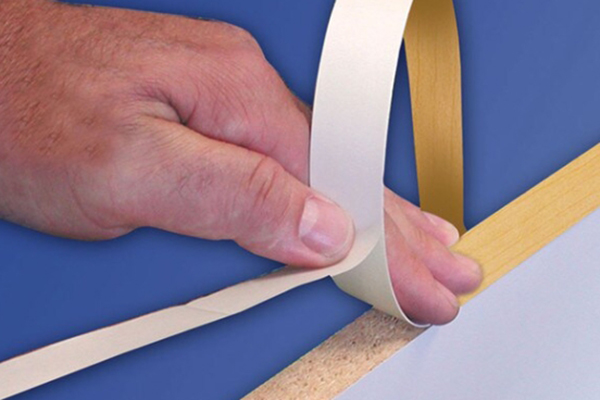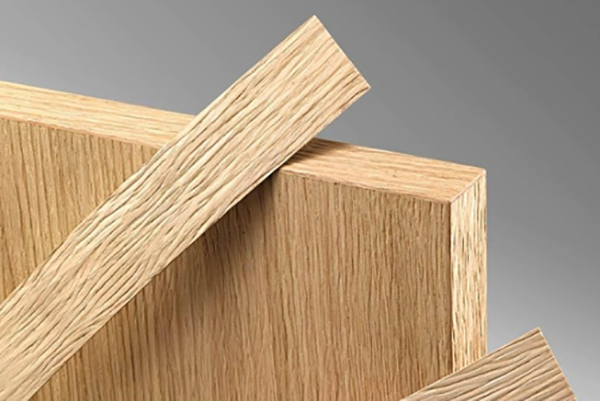This article dives deep into the world of edge banding, comparing two popular materials: ABS (Acrylonitrile Butadiene Styrene) and PVC (Polyvinyl Chloride). We’ll explore their properties, benefits, drawbacks, and applications, helping you understand why understanding the differences is crucial for making the right choice for your furniture manufacturing, cabinet making, or interior design project. This is a worth read because choosing the correct edge banding can dramatically impact the durability, aesthetics, and even the environmental footprint of your finished product.
1. What is Edge Banding and Why is it Important?
Edge banding is a thin strip of material used to cover the exposed, raw edges of wood-based panels like Melamine MDF board panel, particleboard, and plywood. Choosing the right edge banding material is crucial. It serves several vital functions:
- Protection: Edge banding protects the core material from moisture, impact, and wear, significantly extending the lifespan of the furniture or cabinetry. The edges of your furniture are vulnerable, and this protection is vital.
- Aesthetics: It provides a clean, finished look, concealing the raw edge and creating a seamless appearance.
- Safety: It covers sharp edges, preventing injuries.
The edge banding material you choose should be durable, match the design aesthetic, and meet any specific performance requirements (like heat or moisture resistance). Selecting the right edge banding material can make all the difference in the final product’s quality and longevity. You need a durable surface to protect your board edges.

2. What is ABS Edge Banding?
ABS (Acrylonitrile Butadiene Styrene) is a thermoplastic polymer known for its strength, rigidity, and impact resistance. ABS edge banding is a popular choice in the furniture industry, offering several advantages.
- Durability: ABS is highly durable and resistant to impact, scratches, and abrasion. ABS edge banding offers excellent protection, making it ideal for high-traffic areas.
- Environmentally Friendly: ABS is considered more environmentally friendly than PVC. It’s fully recyclable and doesn’t release harmful chemicals during incineration.
- Heat Resistance: ABS has good heat resistance, although it’s not as high as some other materials.
- Convenient to process: The newest laser technology due to the possibility of fusing the material with the board without using glue, is only applicable on ABS edges.

ABS edge banding is available in a wide range of colors, finishes, and textures, making it ideal for various design applications. While ABS edge banding may be slightly more expensive than PVC, its durability and environmental benefits often make it a worthwhile investment.
3. What is PVC Edge Banding?
PVC (Polyvinyl Chloride) is another widely used thermoplastic polymer for edge banding. PVC edge banding is known for its affordability and versatility.
- Cost-Effective: PVC is generally cheaper than ABS, making it a budget-friendly option.
- Water Resistance: PVC is more resistant to water and moisture than ABS, making it suitable for environments like kitchens and bathrooms.
- Flexibility: PVC is more flexible than ABS, making it easier to apply to curved edges.
- The technology of printing and the structure of the surface itself has advanced so much that it is practically impossible to distinguish melamine PVC edge banding from solid wood, stone or aluminum.
However, PVC might have some drawbacks:
- Environmental Concerns: The production and disposal of PVC can raise environmental concerns due to the potential release of harmful chemicals.
- Lower Heat Resistance: PVC is less resistant to heat than ABS, and prolonged exposure to high temperatures can cause it to deform. PVC cannot be used in combination with laser edge banders.
PVC edge banding is a common choice for many applications, particularly where cost is a primary concern, and high heat resistance isn’t required.
4. ABS vs PVC: Key Differences in Composition and Manufacturing
Understanding the difference between ABS and PVC starts with their chemical composition. ABS (Acrylonitrile Butadiene Styrene) is a terpolymer, meaning it’s made from three different monomers: acrylonitrile, butadiene, and styrene. This combination gives ABS its strength, rigidity, and impact resistance. PVC (Polyvinyl Chloride), on the other hand, is made from the polymerization of vinyl chloride monomer.
The manufacturing processes also differ. ABS production typically involves emulsion or mass polymerization, while PVC is often produced through suspension polymerization. These differences in manufacturing contribute to the varying properties of the two materials. One key differences between ABS and PVC is their response to additives. PVC often requires plasticizers and stabilizers to achieve desired flexibility and durability, while ABS generally requires fewer additives.
It’s important to also mention the edges themselves. Because it is possible to use the strongest form of solvent based glues without causing damage to the PVC, these edges often stick better to the substrate than pre-glued ABS.
5. Durability Showdown: ABS vs PVC – Which is Tougher?
When it comes to durability, both ABS and PVC edge banding offer distinct advantages. ABS is generally considered more durable due to its higher impact resistance. It can withstand more significant impacts and is less prone to cracking or chipping. This makes ABS edge banding a good choice for furniture and fixtures that experience heavy use. It is particularly good at withstanding knocks from hard objects and does not chip as easily when being prepared using trimming knives.
PVC, while not as impact-resistant as ABS, offers excellent resistance to scratches and abrasions. PVC edge banding is also highly resistant to water and many chemicals. The choice between ABS and PVC for durability often depends on the specific application and the types of wear and tear the edge is likely to encounter. For high-impact situations, ABS holds the advantage. For resistance to moisture and chemicals, PVC is a strong contender.
6. How Does Heat Resistance Compare Between ABS and PVC?
Heat resistance is a critical factor when choosing edge banding, especially for applications near heat sources, like in kitchens. ABS generally has better heat resistance than PVC. ABS edge banding can withstand higher temperatures without deforming or degrading.
PVC, on the other hand, is more susceptible to heat damage. Prolonged exposure to high temperatures can cause PVC edge banding to soften, warp, or even melt. Therefore, for applications where the edge banding will be exposed to significant heat (e.g., near ovens or cooktops), ABS is the preferred choice. While standard PVC is not resistant to fire, ABS is, and it will also burn for a significantly shorter period. It is also possible to purchase specialist, fire-resistant ABS.
7. Environmental Impact: Is ABS or PVC More Eco-Friendly?
Environmental considerations are becoming increasingly important in material selection. In this regard, ABS is considered more environmentally friendly than PVC. ABS is fully recyclable and can be reprocessed into new products. It also doesn’t release harmful chlorine-based chemicals during incineration.
PVC, on the other hand, presents more environmental concerns. Its production involves the use of chlorine, a highly reactive and potentially harmful chemical. While PVC can be recycled, it’s often more challenging and less common than ABS recycling. Additionally, PVC can release harmful dioxins when burned. PVC doesn’t decompose in the ground. Therefore, if environmental impact is a primary concern, ABS edge banding is the more sustainable choice. ABS is less likely to expose harmful elements and chemicals when exposed to UV lights, unlike PVC.
8. Production Costs: Is ABS or PVC More Economical?
In terms of production costs, PVC often has the edge. PVC edge banding is generally cheaper than ABS due to the lower cost of raw materials and the simpler manufacturing process. This makes PVC a cost-effective solution for many projects, especially large-scale applications where budget constraints are a significant factor.
While ABS is typically more expensive than PVC, the price difference has narrowed in recent years. Furthermore, the longer lifespan and reduced replacement frequency of ABS can sometimes offset the higher initial cost, making it a cost-effective choice in the long run. The best choice, then, might change case by case, and that choice will depend on budget and usage requirements.
9. Application Versatility: Where Can You Use ABS and PVC Edge Banding?
Both ABS and PVC edge banding are versatile materials suitable for different applications. ABS, with its superior impact resistance and durability, is often preferred for:
- Office furniture
- Kitchen cabinets
- Retail fixtures
- High-traffic areas
PVC, with its moisture resistance and affordability, is commonly used in:
- Bathroom vanities
- Residential furniture
- Shelving
- Applications where cost is a primary concern
It’s important to consider the specific needs of your project when choosing between ABS and PVC. Factors like expected wear and tear, exposure to moisture or heat, and budget constraints should all influence your decision.

For example: I am Allen, from China, and my factory specializes in these materials. We supply to major markets like the USA, where Mark Thompson, a typical client of ours, values both quality and price. He often purchases our ABS edge banding for his high-end furniture lines due to its durability, and our PVC edge banding for more budget-conscious projects. We are always looking to improve communication (a pain point for Mark), using exhibitions as a place to solve these problems.
10. Choosing the Right Edge Banding Material: A Summary
Selecting the right edge banding is a crucial decision that impacts the durability, aesthetics, and even the environmental impact of your finished product. ABS and PVC are two popular materials that offer distinct advantages. Here’s a table summarizing the key differences:
| Feature | ABS | PVC |
|---|---|---|
| Composition | Acrylonitrile Butadiene Styrene | Polyvinyl Chloride |
| Durability | Higher impact resistance | Good scratch and abrasion resistance |
| Heat Resistance | Higher | Lower |
| Environmental | More environmentally friendly, recyclable | Less environmentally friendly, potential release of harmful chemicals |
| Cost | Generally more expensive | Generally less expensive |
| Applications | High-traffic areas, office furniture | Residential furniture, bathroom vanities |
Ultimately, the choice between ABS and PVC depends on your specific project requirements and priorities. Consider factors like:
- Durability needs: Will the edge be subject to impacts or heavy use?
- Exposure to heat or moisture: Will the edge be near heat sources or in a humid environment?
- Environmental concerns: Is sustainability a priority?
- Budget: What is your budget for edge banding?
By carefully evaluating these factors, you can make the right choice and ensure the best possible outcome for your project. Remember, it’s not just about ABS vs, it’s about finding the material that best suits your needs. You have a better chance of choosing between PVC and ABS if you understand their qualities, advantages, and disadvantages. Always inspect the edges of the edge banding for quality.
Good Quality melamine paper for plywood decorative melamine impregnated paper.
Wholesales Melamine chipboard wood grain solid color.
Key Takeaways:
- Edge banding is essential for protecting and finishing wood-based panels.
- ABS is durable, environmentally friendly, and has good heat resistance.
- PVC is cost-effective and moisture-resistant.
- The difference between ABS and PVC lies in their composition, manufacturing, and properties.
- Choosing the right edge banding depends on your specific needs and priorities.
- Both ABS and PVC edge banding serve the fundamental purpose of covering exposed edges.
- The selection of the right material requires careful consideration.
By having read the article, you should now be able to understand the differences and you can make a choice between using ABS or PVC.
Post time: 03-11-2025











